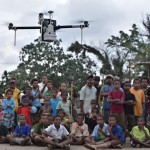Drones Will Make It Easier to Detect Unexploded Bombs in Laos – 16 March 2015
ArchAerial, an aerial imaging company, is planning on making a new drone that can help locate and map out unexploded bombs in former war zone areas. In the past, the Vietnam War has transformed Laos into a dangerous area with undetected explosives, threatening the lives of many citizens. The company wants to focus on areas like this and want to launch their first drone in Laos, using LiDAR remote sensing equipment (which 3-D maps the surface with extreme accuracy). If the drone is a success, it could save the lives of many civilians and keep them from venturing into explosive regions without any prior knowledge of its layout.
ACLU Files New Lawsuit Over Obama Administration Drone ‘Kill List’ – 16 March 2015
The American Civil Liberties Union, a US non-profit organization, is looking to increase its attempts to elicit transparency from the Obama administration surrounding US counter-terrorism strikes. The group plans on filing a disclosure lawsuit against the Obama Administration and make them reveal secret documents containing information about how people get placed on the “kill list” and become targets for drone strikes. ACLU wants to seek information on how the administration takes civilian casualties into account and specifically, “the number and identities of individuals killed or injured” during these drone strikes. Although the government has “stonewalled” and delayed the ACLU’s persistence for quite a while, the Civil Liberties Union is not giving up.
Syria Says It Shot Down U.S. Drone – 17 March 2015
The US military has lost contact with their MQ-1 Predator drone somewhere in the country of Syria. The Syrians are claiming that they have shot down the drone and have a video of the remains as evidence: “Syrian Air Defense systems shot down a U.S. UAV north of Latakia Province” said the Syrian Arab News Agency. The drone was supposedly on a reconnaissance mission, which raises the issue of whether other countries have the right to shoot down enemy drones surveying their territory. The US has formerly used drones for these types of missions, including targeted killings in other countries. According to the New America Foundation, many other countries are also starting to use drones for this type of reason.
The Private Investigator Who Spies Using Drones – 18 March 2015
Private investigator Chris Wright uses drones to spy on people. She makes sure to stay 50 – 75 feet away from the target so that they do not hear the drone. In one case Wright used her drone to figure out if a soda salesman was crossing county lines to cheat his contract.She had the drone follow the supply trucks back to their depots in the middle of the desert, where conventional means of covert observation would have otherwise been impossible. From there she was able to observe the warehouse door and the loading trucks in complete secrecy. Wright does not personally pilot her drones, she hires others more experienced with the controls to reduce the risk of losing or damaging the expensive quad-copters. Some critics question the legality of her methods, and a new California bill might shut down her drone operations, but in the mean time she continues to use them as any other tool.
Is ISIS Building A Drone Army? – 18 March 2015
A U.S. led coalition has taken down an ISIS drone for the first time. The drone was flying around gathering surveillance data, when it landed it was loaded into a vehicle, which was promptly destroyed. The Pentagon quickly dismissed the idea that ISIS was building more deadly drones such as the Reaper and Predator ones owned by the U.S. They stated that the civilian drone market is so large and surveillance equipment so common, that its no surprise ISIS had a few. The only threat they could pose would be kamikaze drones rigged with small explosives.
High-Resolution 3-D Scans Built from Drone Photos – 19 March 2015
In Rio de Janeiro, a small drone was used to take over 2,000 pictures of the 30-meter statue of Christ. Using these detailed photos, the Swiss company Pix4D was able to construct an accurate 3-D model of the statue, accurate within 2-5 centimeters, in only a few short hours. Creating 3-D models from pictures is nothing new, Google and Apple have done it using aircraft in the past, but by using drones the company was able do it faster and cheaper than the conventional methods. The challenges the drones face are high winds and coordinated controls, these are the main focuses of improvement that the team plans to face in the coming future.
Drones and the War on Terror – 20 March 2015
A drone strike has just taken out the planner of the 2013 Kenyan mall massacre. This strike is one of nearly 500 that have taken out terrorist leaders following the 9/11 attacks. Adan Garar was announced dead by the Pentagon on Wednesday, March 18th. The strike was said to have occurred on March 12th. Although this sounds like good news, another terrorist dead, many around the globe continue to criticize the US’s use of drones. For starters, the strikes are said to cost innocent lives as well as terrorist’s. As this may be true, the use of conventional means, either air strike or ground, the cost of American lives is at risk. Furthermore, the weapon systems on drones are becoming more and more precise each day. This will lead to a decrease of innocent casualties, as well as a decrease in American lives lost due to terrorism.
Amazon is Approved to Fly – 20 March 2015
As many already know, Amazon has announced that they would like to use quad-copters to deliver packages quickly and efficiently. Until recently, the FAA has banned even the testing of these drones. As of Thursday, March 19th, the FAA has approved the testing of the Amazon delivery copters; however, the approval comes with many restrictions. During testing, the copters are not allowed to leave the sight of the pilot. This pilot must also have at least a private pilot’s certificate. Along with this, the FAA has many strings attached to minimize the use of the Amazon copters. Although the FAA is being extremely harsh, it shows they are moving in a direction that allows commercial use of drones in the future.
Drones Can Study Marine Life – 20 March 2015
Last week, a group of scientists explored the possibility of using unmanned drones such as quad-copters to study sea turtles. Other than when they are nesting and stranding on shore, turtle activities are unknown to us. Up until now, the use of boats can scare turtles and affect their normal way of life. The use of drones would allow the study of these turtles, as well as other marine life, without disrupting the natural flow of the environment. Not only does this show the increasing impact of drone use for research purposes, but also opens up many doors to uses of drones. These uses also entail humans making an attempt to not disturb animal habitats, which is a positive thought.



